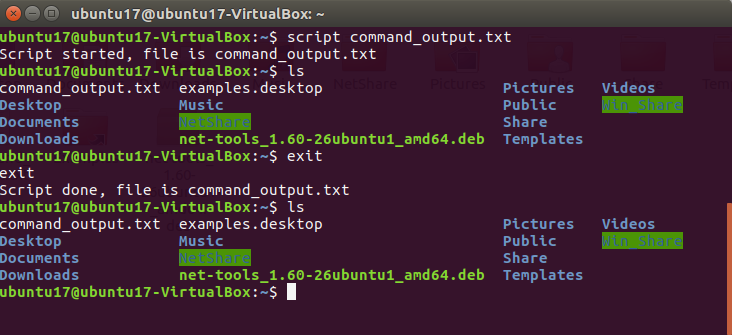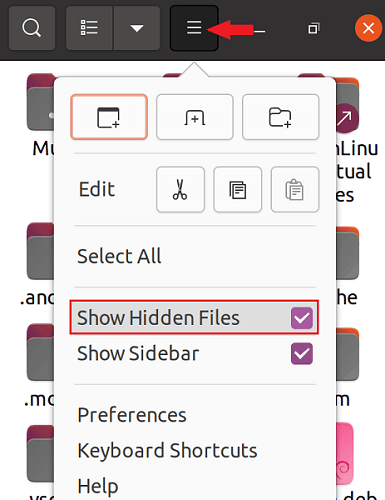

- Show hidden files terminal ubuntu how to#
- Show hidden files terminal ubuntu zip#
- Show hidden files terminal ubuntu free#
Show hidden files terminal ubuntu zip#
Binary entities, like zip files and executable programs, are indicated swith an asterisk ( *). Show Hidden Files in Ubuntu Terminal The ls command option -a will show all files and folders, including hidden ones. If you're color blind or on a display that doesn't provide colors, you can alternately use the -classify option: $ pwdĪs you can see, folders are given a trailing slash ( /) to denote that they are steps within your file system. If you don't see those colors, you can try ls -color. Some Linux distributions have some nice colors set up so that all folders are blue and the files are white and binary files are pink or green, and so on. You may notice that it's hard to tell a file from a folder.

Show hidden files terminal ubuntu how to#
Files and folders and how to tell the difference Once you start moving around within your computer, you can use that information to create shortcuts for yourself or to increase the specificity of your paths. That is, you are in a folder in another folder. The two dots indicate that you can move back from this location. The single dot is actually a meta location meaning the folder you are currently in.
Show hidden files terminal ubuntu free#
Free online course: RHEL Technical OverviewĪs you can see, the first items listed are dots. If you can think of a different solution, do share it in the comment section. The find command is always there for such stuff. Of course, there could be several other possible ways. *ĭrwxrwxr-x 3 abhishek abhishek 4096 Jun 30 10:38. You are displaying both the hidden files and directories and then filtering out the entries starting with d (which are directories). member.csv Display only hidden files (not hidden directories)ĭisplaying only hidden files without the hidden directories is quite easy. You get the desired result now: -rw-rw-r- 1 abhishek abhishek 41145 May 27 15:24. is followed by something (thus single dot is ruled out) except another dot (thus ruling out double dots). !(|.) and you are saying a pattern where. When you negate it with !, you are saying it should not be "nothing" or dot. directories, you can use the ls command like this: ls -ld. Otherwise, the ls command will also show the contents of the. It tells ls to only list the directory, not its contents. So, basically, you can think of it as: ls -ld. hidden-fileĭrwxrwxr-x 2 abhishek abhishek 4096 Jun 30 10:38. As I want to create that folder on desktop, for that, use the. ĭrwxr-x- 28 abhishek abhishek 4096 Jun 29 15:15. Step 1: Open up the terminal, go to the directory in which you want to create a hidden folder. It will show the following result for the example here: drwxrwxr-x 3 abhishek abhishek 4096 Jun 30 10:38. To show just the hidden files and directories in the long listing format (so that you can see if it's a file or directory), you can use this: ls -ld. If you want that, there is another way to achieve that. Though you can see them in individual lines, you cannot distinguish if it's a file or a directory. This is better, right? Here's a screenshot if you want to see them all together in a single image: In this guide, we will discuss the below methods to show the hidden files in Linux: Method 1: Show Hidden Files Using CLI The easiest way to show the list of files available in a directory is using the ls command. You can filter them out by using the -A option instead of -a. In Ubuntu, several ways can be used to unhide the file. Now I am going to filter it out so that it only shows the hidden files and directories: :~/toto$ ls -a | grep "^\." rw-rw-r- 1 abhishek abhishek 143 May 30 12:06 routes.yaml rw-rw-r- 1 abhishek abhishek 12721 May 29 12:29 members.csv rw-rw-r- 1 abhishek abhishek 4943 Jun 2 20:09 gnome-console-voiceover rw-rw-r- 1 abhishek abhishek 249773 May 26 14:56 cronjob-cheatsheet.png rw-rw-r- 1 abhishek abhishek 29983 May 27 16:07 bash.pdf rw-rw-r- 1 abhishek abhishek 45443 May 24 09:03 apt-get.pdf Here's the content of my sample directory: :~/toto$ ls -l With "^\.", you tell grep command to only show results that start with a dot. The dot character needs to be escaped with \ and since you used special characters, everything is enclosed in double-quotes. To display only the hidden files and directories, the simplest approach is to show the hidden files with ls -a and then use grep to filter only the entries that start with a. Display only the hidden files and directories However, you can always find a way to achieve things by combining a few commands through the wonderful pipe redirection. There is no ready-to-use option like -a and -A. What if you want to ONLY see the hidden files, not the regular ones? 
You can see the hidden files with their names starting with a dot (.).īut you see all the files in the current directory, the hidden ones and the regular ones. You use the ls command in this manner: ls -a Displaying hidden files in Linux is quite easy.







 0 kommentar(er)
0 kommentar(er)
